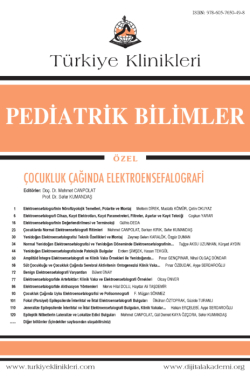Interictal and Ictal Electroencephalography Findings in Generalized Epilepsies, Clinical Cases and Electroencephalography Samples
Hakan ERÇELEBİa, Ayşe SERDAROĞLUa
aÇocuk Nörolojisi BD, Gazi Üniversitesi Tıp Fakültesi, Ankara, TÜRKİYE
Erçelebi H, Serdaroğlu A. Jeneralize epilepsilerde interiktal ve iktal elektroensefalografi bulguları, klinik vakalar ve elektroensefalografi örnekleri. Canpolat M, Kumandaş S, editörler. Çocukluk Çağında Elektroensefalografi. 1. Baskı. Ankara: Türkiye Klinikleri; 2019. p.110-9.
ABSTRACT
Epilepsy is a clinical diagnosis. Besides clinical data, EEG (electroencephalography) is the most important diagnostic tool in the diagnosis of epilepsy. The correct evaluation of epileptiform discharges in EEG is crucial. Generalized epileptiform discharges ocur synchronously and symmetrically in both hemispheres. Ictal and interictal activities in generalized epilepsies are multiple spikes, multiple spike and slow waves, spike or sharp and slow waves, irregular spikes or sharp waves and hypsarrhythmia. In this review, interictal and ictal EEG findings of absence epilepsy, generalized tonic clonic seizures, myoclonic seizures, infantile spasm and tonic seizures will be described with clinical cases and EEG samples.
Keywords: Electroencephalography; epilepsy, generalized
Kaynak Göster
Referanslar
- Fisher RS, Cross JH, French JA, Higurashi N, Hirsch E, Jansen FE, et al. Operational classification of seizure types by the International league against epilepsy: position paper of the ILAE Commission for Classification and Terminology. Epilepsia. 2017;58(4):522- 30. [Crossref] [PubMed]
- Holmes GL. Generalized seizures. In: Swaiman KF, Ashwal S, Ferriero DM, Schor NF, Finkel RS, Gropman AL, et al, eds. Swaiman Pediatric Neurology. 6th ed. Edinburg: Elsevier; 2017. p.524-30.
- Sato S, Dreifuss FE, Penry JK, Kirby DD, Palesch Y. Long-term follow-up of absence seizures. Neurology. 1983;33(12):1590-5. [Crossref] [PubMed]
- Sadleir LG, Farrell K, Smith S, Connolly MB, Scheffer IE. Electroclinical features of absence seizures in childhood absence epilepsy. Neurology. 2006;67(3):413-8. [Crossref] [PubMed]
- Laoprasert P. Atlas of Pediatric EEG. Colorado: McGraw Hill Medical; 2011. p.613-7.
- Pillai J, Sperling MR. Interictal EEG and the diagnosis of epilepsy. Epilepsia. 2006;47 Suppl 1:14-22. [Crossref] [PubMed]
- Smith SJ. EEG in the diagnosis, classification, and management of patients with epilepsy. J Neurol Neurosurg Psychiatry. 2006;76 Suppl 2:ii2-7. [Crossref] [PubMed] [PMC]
- Park KI, Lee SK, Chu K, Lee JJ, Kim DW, Nam H. The value of video-EEG monitoring to diagnose juvenile myoclonic epilepsy. Seizure. 2009;18(2):94-9. [Crossref] [PubMed]
- Oguni H, Fukuyama Y, Imaizumi Y, Uchara T. Video-EEG analysis of drop seizures in myoclonic astatic epilepsy of early child hood (Doose syndrome). Epilepsia. 1992;33(5):805- 13. [Crossref] [PubMed]
- Korff CM, Nordli DR Jr. The clinical-electrographic expression of infantile seizures. Epilepsy Res. 2006;70 Suppl 1:S116-31. [Crossref] [PubMed]
- Hrachovy RA, Frost JD Jr. Infantile epileptic encephalopathy with hypsarrhythmia. (infantilespasms/West syndrome). J Clin Neurophysiol. 2003;20(6):408-25. [Crossref] [PubMed]
- Hrachovy RA, Frost JD Jr. The EEG in selected generalized seizures. J Clin Neurophysiol. 2006;23(4):312-32. [Crossref] [PubMed]
- Haga Y, Watanabe K, Negoro T, Aso K, Kasai K, Ohki T, et al. Do ictal, clinical, and electroencephalographic features predict outcome in West syndrome? Pediatr Neurol. 1995; 13(3):226-9. . [Crossref] [PubMed]
- Scheltens-de Boer M. Guidelines for EEG in encephalopathy related to ESES/CSWS in children. Epilepsia. 2009;50 Suppl 7:13-7. [Crossref] [PubMed]

